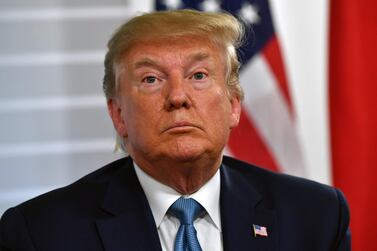Oil prices slumped to a two-week low after trading resumed on Monday, as tit-for-tat tariffs by the world's biggest economies caused a sell-off by traders, before bouncing back after the US and China both suggested they could ease up in their trade war.
Benchmark Brent was down by 0.81 per cent, trading at $58.86 per barrel at 10.31am UAE time on Monday, as global commodities and stocks dropped sharply in early trading in Asia after US President Donald Trump's decision to raise tariffs on China by a further 5 per cent.
West Texas Intermediate, the benchmark that tracks largely North American crude grades, was down by nearly 1 per cent, trading at $53.64 at 10.30am UAE time. WTI has been hit harder as China imposed retaliatory tariffs of 10 per cent on $75 billion ( worth of US goods, including crude.
Around 6 per cent of US crude production is destined for China, the world's biggest importer of oil.
However, by 5:10pm UAE time, Brent was up 40 cents at $59.74 a barrel while US oil was up 73 cents at $54.90 a barrel.
US President Donald Trump said on Monday he believed China was seeking a trade deal after he said Beijing contacted US officials overnight to say it wanted a return to talks.
Friday's escalation between the world's two largest economies came after Mr Trump's decision to impose 10 per cent tariffs on $300bn worth of Chinese goods on August 1. The move led to Brent and WTI registering their steepest single-day declines in four years. The yuan was also hit hard by the move, breaching a level of 7 yuan to the US dollar, which was considered a benchmark.
China followed up with retaliatory tariffs at the weekend, which prompted Mr Trump to raise the tariff to 15 per cent and increase tariffs on $250bn worth of imports to 30 per cent, having previously imposed a 25 per cent levy.
Beijing also announced the resumption of a 25 per cent tax on US vehicles and a 5 per cent tax on auto parts and components, which are set to begin on December 15. China had frozen the auto taxes in April.
On Sunday, at the Group of 7 meeting in Biarritz, France, Mr Trump was quizzed about his policy moves. He initially said that he had "second thoughts" about the recent trade escalation. The White House later clarified, saying Mr Trump "regretted" not having raised tariffs even higher.
"The decision to include crude oil in the latest list of Chinese 10 per cent retaliatory tariffs on US goods would likely to see flows return to levels seen over the winter of 2018-2019 — namely to zero," Energy Aspects said in a note.
Some rerouting is expected in US crude flows to China, which has remained rather subdued since last October, with around 250,000 barrels per day exported in May, according to data from the Energy Information Administration. However, flows had picked up earlier this year and the latest escalation of tariffs is likely to suppress demand from China, one of the biggest drivers for crude demand growth globally.
"In practical terms, this is likely to mean a repeat of the kind of crude rerouting we saw from Q4-2018, with Chinese imports of equivalent light barrels from WAF [West African crude] or the North Sea increasing, hurting Chinese refining economics slightly at the margin," added Energy Aspects.








